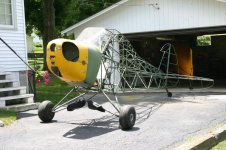Having a lot of experience with automotive finishes, as well as commercial finishes and electrostatic painting, I can tell you that ANY paint that can be atomized, CAN be applied with electrostatic equipment.
I do own electrostatic spraying equipment, and have used it extensively.
An electrostatic sprayer works best, when what you are painting is metal and mostly air, like the Cub aircraft frame in this photo.

The other benefits are: (a) You can get a more consistent coating thickness, (b) Edges and difficult to reach areas get better coating, (c) Reduced overspray. (d) Reduced material usage.
Most of the paint sprayed with conventional equipment at a tubular assembly like this aircraft frame, is going to miss the tubing all together. Electrostatic spraying allows much more material to hit the target by applying a positive charge to the paint as it leaves the gun, and a negative charge to the frame.
Also, many factories do use an entirely different type of paint than we do. This paint requires high temperatures, (generally 400 degrees F), to set. Which can result in a more durable finish than the air dried, or forced dried finishes that we use. These are called thermoseting finishes. The chemical reaction that makes them go from a liquid to a solid, is triggered only by heat.
These products are not generally made available to the public. Nor are they packaged in small containers.
They can use this type of finish because things are not assembled, so they don't have to worry about melting stuff when they bake it, as we do in the body shop.
We generally don't use more than 200 degrees F, to dry cars. They call it "baking" but it isn't really, it's just forced drying. Without the heat, automotive paint will still harden. The heat doesn't make automotive paint harder, it drives out the solvents, which reduces the cure time, and makes it hard SOONER.

